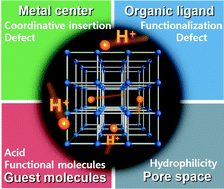Rational strategies for proton-conductive metal–organic frameworks
Abstract
Since the transition of energy platforms, proton-conducting materials have played a significant role in broad applications for electrochemical devices. In particular, solid-state proton conductors (SSPCs) are emerging as the electrolyte in fuel cells (FC), a promising power generation technology, because of their high performance and safety for operating in a wide range of temperatures. In recent years, proton-conductive porous metal–organic frameworks (MOFs) exhibiting high proton-conducting properties (>10−2 S cm−1) have been extensively investigated due to their potential application in solid-state electrolytes. Their structural designability, crystallinity, and porosity are beneficial to fabricate a new type of proton conductor, providing a comprehensive conduction mechanism. For the proton-conductive MOFs, each component, such as the metal centres, organic linkers, and pore space, is manipulated by a judicious predesign strategy or post-synthetic modification to improve the mobile proton concentration with an efficient conducting pathway. In this review, we highlight rational design strategies for highly proton-conductive MOFs in terms of MOF components, with representative examples from recent years. Subsequently, we discuss the challenges and future directions for the design of proton-conductive MOFs.



 Please wait while we load your content...
Please wait while we load your content...